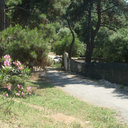[Investigation of Microsporidia prevalence by different staining methods in cases of diarrhea].
الكلمات الدالة
نبذة مختصرة
Microsporidia, depending on their different species, generally lead to self-limited, sporadic and mild infections such as diarrhea, corneal ulcer and myositis. They are considered as opportunistic pathogens in HIV-positive patients however in recent years Microsporidia have been detected also in immunocompetent individuals as a cause of diarrhea. Diagnosis of Microsporidia depends on the detection of spores or different developmental stages of protozoon in stool, urine, sinus aspirates, nasal discharge, bronchoalveolar lavage or tissue biopsies. Diagnosis of Microsporidia infections is usually achieved by the use of different staining methods, serological tests, polymerase chain reaction, and electron microscopic methods. The aims of this study were to detect the incidence of microsporidia in patients with diarrhea by using three different staining methods and to compare the performance of these methods. A total of 225 stool samples from diarrheal patients (84 were children, 141 were adults; 103 were female, 122 were male) admitted to Gazi University Medical Faculty Hospital between March-June 2009, have been evaluated in the laboratory of Medical Microbiology Department. Stool samples were examined in terms of the presence of Microsporidia spores by Weber's modified trichrom staining (MTS), calcofluor (CF) and acridine orange (AO) staining methods. Microsporidia positivity rate was 9.8% (22/225) in the diarrheal patients, the rate being 9.5% (8/84) in children and 9.9% (14/141) in adults. There was no statistically significant difference between age and gender groups (p> 0.05) regarding Microsporidia detection. When MTS was considered as the reference method, sensitivity, specifity and consistency of AO staining were estimated as 100%, 91.6% and 92%, respectively, while those rates for CF staining were 95.4%, 99.5% and 99%, respectively. There was very strong and significant correlation (r= 0.950, p< 0.001) between CF staining and MTS, while there was strong and significant (r= 0.719, p< 0.001) correlation between AO staining and MTS. Although AO staining is rapid and convenient, the positive predictive value was measured very low (56.4%) and the interpretation of stained slides was very difficult since background of the slides was stained orange and there were a lot of dye artefacts. In conclusion, screening Microsporidia in all diarrheal stool samples is of diagnostic value. To increase sensitivity and reliability in the detection of Microsporidia spores in diarrheal samples, initial application of calcofluor staining should be followed by the confirmatory MTS method.



